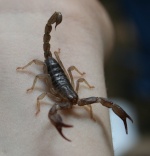| | C sculpturatus slings question |  |
|
|
| Author | Message |
|---|
Trip59
Pandinus
Number of posts : 24
Age : 47
Registration date : 2008-12-31
 |  Subject: C sculpturatus slings question Subject: C sculpturatus slings question  1/22/2009, 1:58 am 1/22/2009, 1:58 am | |
| Hi All, I picked up 15, 2/3 instar slings a couple weeks ago, C sculpturatus, have a concern. I was going to put them in a 5, realized it was way too big, but one had already jumped into a piece of cork bark. Unable to get it out, I set them up in a 2. Sand/coco fiber substrate, cork bark, lamp for heat, 80-85 on cool end 90-95 on hot end, IR thermo for taking temp. Misting the tank every day, since the heater is running and even though I'm in FL it's only about 40% in the office WITH the humidifier running. Tossing in pinheads every couple days, not really seeing any dead crix.
So, whats the concern? I've lost two, both turned dark and just died. I see one or two occasionally, but even moving the cork around haven't seen others. Found one exo, so there was one molted yesterday. Am I ok with the 2 gallon, do I need to fit the cork into smaller container? how many of 15 should I expect to make it? how many pinheads should I toss in each week? Am I overreacting, are they just hiding?
Trip | |
|
  | |
Mr. Mordax
Administrator

Number of posts : 7743
Age : 38
Location : PNW
Registration date : 2008-02-06
 |  Subject: Re: C sculpturatus slings question Subject: Re: C sculpturatus slings question  1/22/2009, 2:25 am 1/22/2009, 2:25 am | |
| SEPARATE THEM ASAP!! Buthid slings do NOT do well with each other until they're adults.
Also, in containers that large, it's hard for them to find prey.
Separate them all into smaller containers, such as large vials or medium delicups, and give each a piece of bark to hang from during molting.
Also, this species comes from deserts in the southwest -- they do NOT need water misted.
Hope this helps | |
|
  | |
Mr. Mordax
Administrator

Number of posts : 7743
Age : 38
Location : PNW
Registration date : 2008-02-06
 |  Subject: Re: C sculpturatus slings question Subject: Re: C sculpturatus slings question  1/22/2009, 2:25 am 1/22/2009, 2:25 am | |
| Also, you may have some hiding in the tiny nooks and crannies of the bark -- you can probably find a good portion of them with a blacklight. | |
|
  | |
Trip59
Pandinus
Number of posts : 24
Age : 47
Registration date : 2008-12-31
 |  Subject: Re: C sculpturatus slings question Subject: Re: C sculpturatus slings question  1/22/2009, 3:15 am 1/22/2009, 3:15 am | |
| Wow, thanks, shoot, I guess I missed that in my research. I saw a number of care sheets that said they did better whith a bit of humidity...
I can separate them out, I have plenty of vials, but how to I get them to come out of the nooks and crannies? Any tricks?
I have a blacklight, been using it to try to find them, is how I found the couple deceased and one walking. | |
|
  | |
Mr. Mordax
Administrator

Number of posts : 7743
Age : 38
Location : PNW
Registration date : 2008-02-06
 |  Subject: Re: C sculpturatus slings question Subject: Re: C sculpturatus slings question  1/22/2009, 3:34 am 1/22/2009, 3:34 am | |
| For getting them out, the most I can suggest is a small probe that you can maybe get behind them and scootch them out with.
Maybe a little humidity at one end of the tank, but these guys are fairly common around Arizona and Nevada and aren't burrowers, so they don't find a lot of moisture in their environment. | |
|
  | |
*Connie*
Post-whore

Number of posts : 3705
Age : 40
Location : England
Registration date : 2008-02-06
 | |
  | |
Trip59
Pandinus
Number of posts : 24
Age : 47
Registration date : 2008-12-31
 |  Subject: Re: C sculpturatus slings question Subject: Re: C sculpturatus slings question  1/22/2009, 4:32 am 1/22/2009, 4:32 am | |
| Ok, so, with the help of a blacklight, I separated 11 into their own containers, little sand, little coco, cork sliver sliced off a spare ugly piece I had. 9 nailed a pinhead within a second, the other two are slowly following them.
So counting the two I found deceased, I'm missing two. I've left the 2 gallon set up, can't see them in the bark, but then again on my first round I only found 8, the other three crawled out while I was getting a drink. Hopefully the other two will as well.
What size will they live together? I'm a little bummed I didn't see this in the research I did, and didn't hear it from the seller when I mentioned putting them all in a 5 to start (I didn't think about the size till they arrived, then it hit me how small they were).
They're on my sling shelf with my 10 T slings. How often 2/3 instar would you feed them? | |
|
  | |
Mr. Mordax
Administrator

Number of posts : 7743
Age : 38
Location : PNW
Registration date : 2008-02-06
 |  Subject: Re: C sculpturatus slings question Subject: Re: C sculpturatus slings question  1/22/2009, 11:55 am 1/22/2009, 11:55 am | |
| Offer food at least once a week, more often if they look skinny. It's possible the remaining two got munched (especially if they molted). Good job on getting them separated.  It sounds like they were having a hard time finding prey in the big tank based on their response to being offered pinheads. You can keep them together when they're adults. You'll notice mature males by the long tail; when you see specimens that same size but without the long tail you'll know you have mature females. | |
|
  | |
Trip59
Pandinus
Number of posts : 24
Age : 47
Registration date : 2008-12-31
 |  Subject: Re: C sculpturatus slings question Subject: Re: C sculpturatus slings question  1/22/2009, 2:25 pm 1/22/2009, 2:25 pm | |
| That was a brand of fun I'd like to not repeat... not to mention I'm really bummed I lost 2, maybe 4 of them... I had only planned to keep 10 or so, but was planning on giving the others to a friend.
So is the adult size of 2-3" body, or body and tail, and if so, how to you measure without holding the tail down?
Trip | |
|
  | |
Mr. Mordax
Administrator

Number of posts : 7743
Age : 38
Location : PNW
Registration date : 2008-02-06
 |  Subject: Re: C sculpturatus slings question Subject: Re: C sculpturatus slings question  1/23/2009, 2:09 am 1/23/2009, 2:09 am | |
| I think that would include the tail; US Centruroides spp. don't get particularly large (as opposed to the Central American monsters). With a live specimen, the best way is probably just photographing it walking beside a ruler and estimating the uncurled length. Here's a picture of a male and female C. hentzi to get an idea of how the tails on mature males look:   | |
|
  | |
Sponsored content
 |  Subject: Re: C sculpturatus slings question Subject: Re: C sculpturatus slings question  | |
| |
|
  | |
| | C sculpturatus slings question |  |
|

